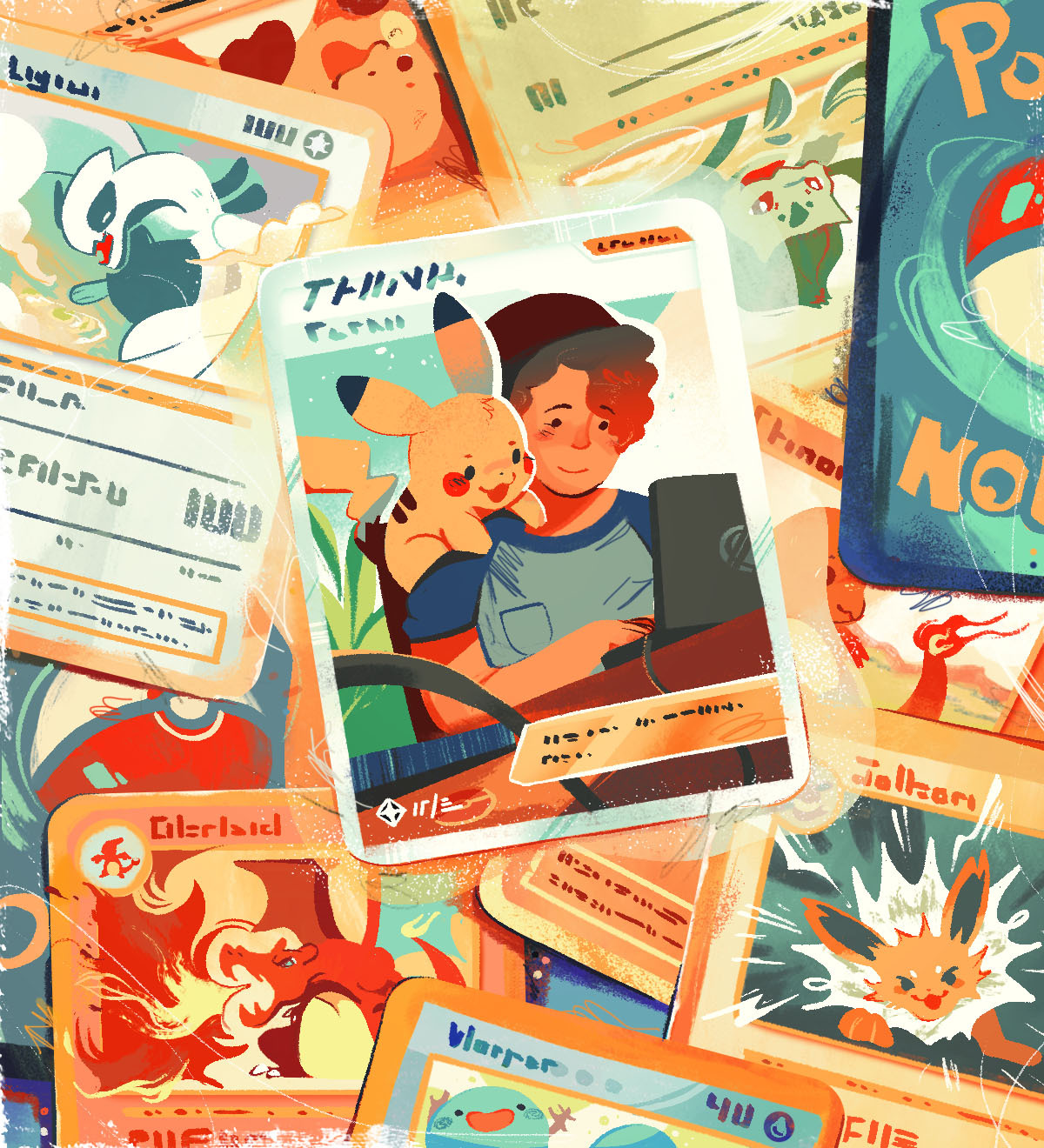As my partner and I were preparing to move in together, earlier this spring, she pulled out a box of Pokémon cards she had held on to since she was a kid in the ’90s.
“Want to see if these are worth anything?” she asked me offhandedly.
We’d heard that Pokémon was making a comeback. Vintage Charizard cards were going for thousands of dollars: last year, YouTuber Logan Paul bought one for $150,000 while rapper Logic reportedly paid $220,574 for the same version (all figures US).
I took out the stack of a few dozen cards, stored all these years in a decoupage tin and mixed with other tokens of the era—buttons and pieces of cardboard bearing Sailor Mercury’s likeness—and, one by one, started to search for them on pricing websites.
The first few queries yielded expected results for twenty-year-old childhood relics: $5 here, $7 there. Then I picked up one card featuring a holographic image of the turtle-like Blastoise. This little monster was among the most iconic Pokémon—the final evolution of one of the three starters players can choose from in the classic Game Boy game. If any of the cards was going to be worth something, it was this one.
I typed its name and number into the search bar, and when the results appeared, I dropped the card in shock. Of the first five listings that appeared for the Blastoise, the lowest was a cool $820. And if we had the coveted first-edition version? A professionally graded mint-quality copy was going for nearly $50,000.
A quick glance at its price history showed me that this piece of shiny cardboard that my girlfriend had ferried around from crappy apartment to crappy apartment was not only pricey but, thanks to a global pandemic that had renewed interest in collectible cards, more valuable than ever.
Pokémon may forever be associated with the schoolyards of the ’90s, but trading cards have been around for much longer. In the late nineteenth century, the original “trade cards” were inserted into the backs of cigarette packs and functioned as both advertisements for businesses or products and stiffeners for extra protection. Since they often featured amusing cartoon-like images, people began collecting them in scrapbooks. Sports cards—mainly for baseball—quickly followed suit.
Trading-card games, however, are a relatively new phenomenon. In 1991, mathematician Richard Garfield was challenged by his friend, Wizards of the Coast founder Peter Adkison, to combine the popularity of baseball cards with a board game. The idea was for players to accumulate a collection of various cards to build a deck and play with. Two years later, Garfield launched Magic: The Gathering—widely recognized as the first trading-card game—which quickly sold out after its first run and spawned the creation of other beloved games, including Pokémon and Yu-Gi-Oh, in the late ’90s.
People of all ages still play these tabletop games, but a blossoming secondary collectors’ market has emerged, particularly for the acquisition of rare vintage cards from the original print runs.
Last year, eBay reported that there were over 4 million more trading cards sold on the platform than in 2019, with Pokémon sales increasing by 574 percent. Outside of eBay, professional auction sites are pulling in record sales of vintage sports and trading cards nearly every month. At one of those auctions this June, an autographed Tom Brady rookie card was listed for $750,000 and, after a manic thirty-two-bid war, was eventually sold to an anonymous buyer for over $3.1 million—a price some might consider a steal compared with the NBA and MLB cards that sold over the past year for $5.2 million each.
The collector frenzy isn’t just happening online. While other brick-and-mortar retailers suffered under the weight of COVID-19—the Canadian Federation of Independent Business estimates that one in six small businesses could close due to the pandemic—game stores saw their sales surge.
Dylan Kirkup, the e-commerce manager at Toronto’s 401 Games, which buys and resells old trading cards, says sales of products like Pokémon cards doubled and even tripled over the course of 2020. “Other businesses were seeing a lot of the negative effects of the pandemic and these lockdowns,” he says. “We found ourselves on the exact opposite end of that spectrum.”
When my girlfriend purchased her small Pokémon collection as an eight-year-old in 1999, she was more interested in the pretty pictures of her favourite characters than in actually playing the game. But that half-hearted interest—coupled with her hesitation to throw things away—paid off. The same millennials who collected those cards as kids but didn’t hold on to them are now adults with jobs and money to spend, and since social activities, travel, and big-ticket expenses have been largely on pause, it makes sense that some people would invest those excess funds into collectible cardboard.
From some quick internet research, I learned that our high-priced collectible was even more valuable because it was from the first Pokémon card set ever printed, commonly known as the base set. Cards from the first run of that set bear a fancy little “first edition” stamp on the left-hand side, and those are the highest valued, netting auction prices of hundreds of thousands of dollars. This March, a first-edition Charizard broke a record as the most expensive Pokémon card ever sold, racking up $399,750 on Goldin Auctions. Our card was from the second run of that first set—commonly known as “shadowless” because the card’s image box doesn’t have a drop shadow behind it like on later printings. Shadowless cards are not as rare as first-edition cards, but they’re a lot more rare—and expensive—than other cards from the base set.
Zack Browning is an expert in the minute details that make these types of cards so valuable. The Chicago-based card collector boasts one of the most expansive Pokémon collections in the world, which he estimates is worth somewhere between $3 and $5 million and which includes mint-condition versions of nearly every card from the vintage ’90s era. Browning started collecting cards as a kid, when his grandmother would gift him packs. But, when he became an adult, it became a part-time pursuit.
“When I left college, I started making a little bit of money, and I wanted to spend some of it on what I enjoyed as a kid, so I went and bought some Pokémon cards and started building sets,” he says. “It’s developed into this massive pursuit, but that was never initially the goal . . . . I’ve helped many, many others follow their passions and find their own childhood collections.”
As it turns out, nostalgia is a valuable commodity. According to research by Le Moyne College psychologist Krystine Batcho, our attraction to the past increases during times of great instability or change—like, say, a global pandemic. She has found that people with greater propensities for nostalgia are better able to cope with adversity and turmoil.
“One of the most important aspects of being a healthy human being is having a sense that you are in control of things,” Batcho said during a 2019 interview with the American Psychological Association. “When things start to change . . . it’s comforting to have a nostalgic feeling for the past that reminds us that, although we don’t know what the future is going to bring, what we do know is that we know who we have been and who we really are.”
While COVID-19 may have spurred the renewed interest in collectibles, Browning predicts that these cards will become even more valuable as the millennials who first drove the craze in the ’90s earn more money to put toward recapturing their schoolyard obsessions. As time passes, he says, people tend to feel more nostalgic for their childhoods—a longing soothed, perhaps, by holding a shadowless Blastoise or a Tom Brady rookie card in their hands. And they’ll always pay a premium for that.
While I was tempted to hold on to the Blastoise in the hope that our descendants could make thousands off it in a few decades, we ultimately decided to sell the card. On a crisp March day in a Vancouver park, I met a man from one of the many Facebook Marketplace groups I joined this year. I’d listed the card for what felt like a reasonable deal considering its slightly roughed-up condition compared with similar ones I saw on eBay, and he ended up offering me around $300 for it.
Between that and the money I made from selling some dozen other cards we’d pulled out of the closet, my girlfriend and I netted enough for a new couch, which in our current life is more useful than being able to relive our pasts.
When I handed off the card in the park, the guy’s eyes lit up. I asked him what he planned to do with it—if he would go to the trouble of professionally grading it to resell to some other collector down the line or keep it long-term for his own nostalgia.
He said he might keep it for his kids to have in twenty years, so they could see what his childhood was like.





